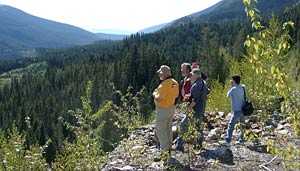Podzolic soils (or Spodosols in USDA Soil Taxonomy) are forested soils found primarily on sandy deposits in ecozones (or parts of ecozones) where the mean annual precipitation is above 700 mm. Coniferous-dominated plant communities are the major vegetation type found on Podzolic soils. Podzolic soils have B horizons that are enriched with amorphous material composed of humified organic matter, aluminum and iron. These soils generally have organic surface horizons, a light coloured eluvial horizon (which may be absent), and a reddish to black B horizon with an abrupt upper boundary.
There are three great groups of the Podzolic order.
Humo-Ferric Podzol Great Group
These soils have a Bf horizon thicker than 10 cm (or Bhf + Bf > 10 cm thick), organic C between 0.5 and 5%, and occurs at the drier end of the Podzolic range.
Humic Podzol Great Group
These soils are found at the wetter end of the range (either by region or landscape position) and have a Bh horizon thicker than 10 cm, and organic C > 1%.
Ferro-Humic Podzol Great Group
These soils occupy the intermediate position in the range. The Ferro-Humic Podzols have a Bhf horizon thicker than 10 cm and organic C >5%.
